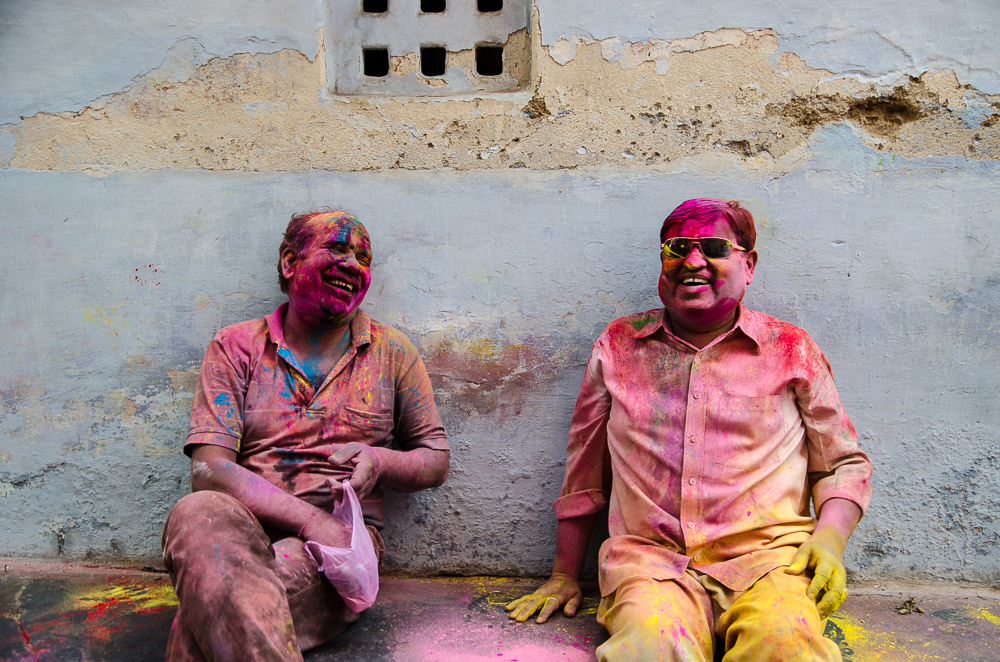Angie Evans, Washington, DC, SSH Blog Correspondent

You can’t emotionally prepare yourself for sexual harassment or assault. It’s 11:15 a.m. and I am sitting on the rooftop of a guesthouse in Udaipur, India. My teeth are covered in purple chalk. From my fingertips to my elbow there is a splash of bright pink dye, later I will have to accept that my arm is going to be fuchsia for weeks. In the street I can hear kids laughing as they toss colors into the air. Two Grandfathers sit on a stoop below, chuckling with each other. I slump into a chair and breath for the first time in hours. Two other women sit with me. One had her shirt nearly ripped off by a group of teenagers and the other had to slap someone in the street for trying to run his hand across her chest. I’d had chalk smeared into my eyes by a man while his friend came up from behind me and grabbed by breasts.
Although Holi, the Hindu festival of colors, tops the bucket list for tourists all over the world, it isn’t the same experience for for all genders. The playful celebration that was traditionally held with family and friends relaxes many social norms between men and women, allowing some to use it as an excuse for groping, fondling, and grabbing women in the streets. In a culture so deeply rooted in spiritual practice and values, what is bubbling beneath the surface?
Reports of sexual assault in India have increased over the years, resulting in a continuous decline in the foreign tourism sector. In 2013, female travelers decreased by over a third in just 3 months. Hotel operators, travel agents, and others in the industry were undone by such a steep decline. The international community was enraged by story after story of sexual assault. The first female chief justice was assigned to the the Delhi high court, immediately taking notice of some negative gender dynamics. An urgency prompted governmental investigations in national, state, and local Indian agencies.
Change is hard in a country with 1.2 billion people, but it’s an inevitable part of growth. A number of new policy measures have made female residents and travelers more safe in India. So what lessons can we learn from the policy changes and movement building in India around sexual harassment and assault?
1. Female Participation
When the Indian state of Gugarat decided to make a strong statement on sexual harassment, they set up a council to educate, mediate, and set policy framework within the high court. They made sure to prescribe exactly what kind of position in the system each member should have, and set a minimum quota for female participants. This isn’t the only governing body that set up a review board or fixed the number on the board, but it set a strong precedence for local communities.
2. Police Consent and Government Engagement
It is hard to know the true impact of sexual harassment in communities because it continues to be underreported for many reasons. In Delhi, they recognized that many victims felt uncomfortable calling the police so they set up a separate hotline just for sexual harassment and assault victims. They also started an on-going series of free self defense courses to female residents. In Ahmedabad, the police posted billboards in high traffic areas, offering a free ride home to any women who feel unsafe. The court systems are undeniably slow, and until this is changed, law enforcement officials need to play a strong role.
3. Education
India is slowly working on implementing one of their new laws, which protects women from workplace sexual harassment. A key part of that has become educating staff. This is important because the onus cannot be on women to stop the harassment, it must be on how men treat their female counterparts. Like all sexual harassment interventions in India, it must be about the perpetrator and not the victim in order to see fundamental change.
4. Make Streets Safe
Delhi is known worldwide for it’s confusing streets, lack of addresses, and chaotic traffic. Following the UN Safe Cities Global Initiative, the municipal government set up an audit for urban planning, identifying key ways that they could improve the safety of their city. Things as simple as street lights and better designed public restrooms can vastly improve safety records in a city. There are a number of Indian cities reviewing this checklist to find areas of improvement.
5. Support Survivors
Setting up sexual harassment and assault hotlines is the first step in a community response. Some organizations in India are making this the focus of their intervention because for many victims, it is a silent daily battle. In equipping these women with an emotional outlet, as well as the tools to respond to future experiences, you build an intervention that empowers each woman.
Organizations all over India are continuing to bring up problems with sexual harassment and assault, and will continue to fight for systemic and societal changes, because they haven’t reached a point where the laws represent the real values of the country. For a nation to truly grow and thrive, the equality of women must be central. And with women and children representing 70% of the population, this isn’t just the right thing to do in India, it’s good economic sense.
Angie is a community organizer and social worker. Last year she quit her job to travel around the world with her husband. They have just returned and are continuing to write about travel and adventure at http://whereisseangie.com


